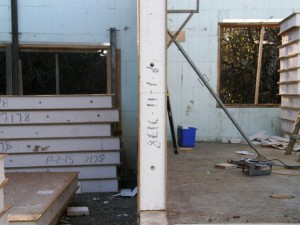
Part of our exterior wall system were constructed with structured insulated panels (SIP). We used these panels in two areas: in areas where we could not use ICF because of a lack of a supporting wall underneath to bear the weight of the concrete in the ICF, and in wall areas that faced into an unconditioned area, such as the wall separating the garage and the living space, and a section of walls that faced into the lower attic.
Our SIPs are made of two sheets of oriented strand boards (OSB), with expanded polystyrene (EPS, aka Styrofoam) sandwiched in between. Various sizes and thickness are available, and for the majority of the SIPs we used had either 4’x9′ or 4’x10′ sheets that were 8 1/4″ thick in total (7 1/4″ EPS). Channels at the edge are carved out for installation of splines using 2×8 lumber as well as for the plates. Every 4′ a spline was installed, and glued and nailed together to the OSB. In our case, we had ordered the panels with built-in channels for electrical wiring. What surprised us was how rigid the wall system as we were installing even without the nails in place; the tight fit of the spline to the OSB and the rigidness of the SIP allowed it to stand on the base plate with no flex whatsoever.
Benefits include an air tight structure, and reduced thermal bridging compared to traditional timber frame, as “studs” are every 48″ instead of every 16″. The fit between the OSB and the spline/plates are also very tight and glued together to minimize potential air leakages.
In costs, we estimated this to be about a $3/sq.ft. wall space upcharge for material and labour from traditional timber framing, and about $6/sq.ft. less than the ICF.
Our SIPs are from Insulspan, sourced through Kent Trusses (who also supplied our floor and roof trusses). The SIPs were ordered in 6 1/2″ and 8 1/4″ thicknesses, in 4’x9′ and 4’x10′ sheets, with wiring channels put in at 14″ and 44″ from floor.
CaGBC LEED for Homes – Points can be achieved in Energy and Atmosphere, either via the air leakage tests (EA 3.3) or exceptional energy performance (EA 1.2) via the ERS/HERS method. Points is also available in Material and Resources (MR 1.4) for SIP and MR 2.2 for local content.
